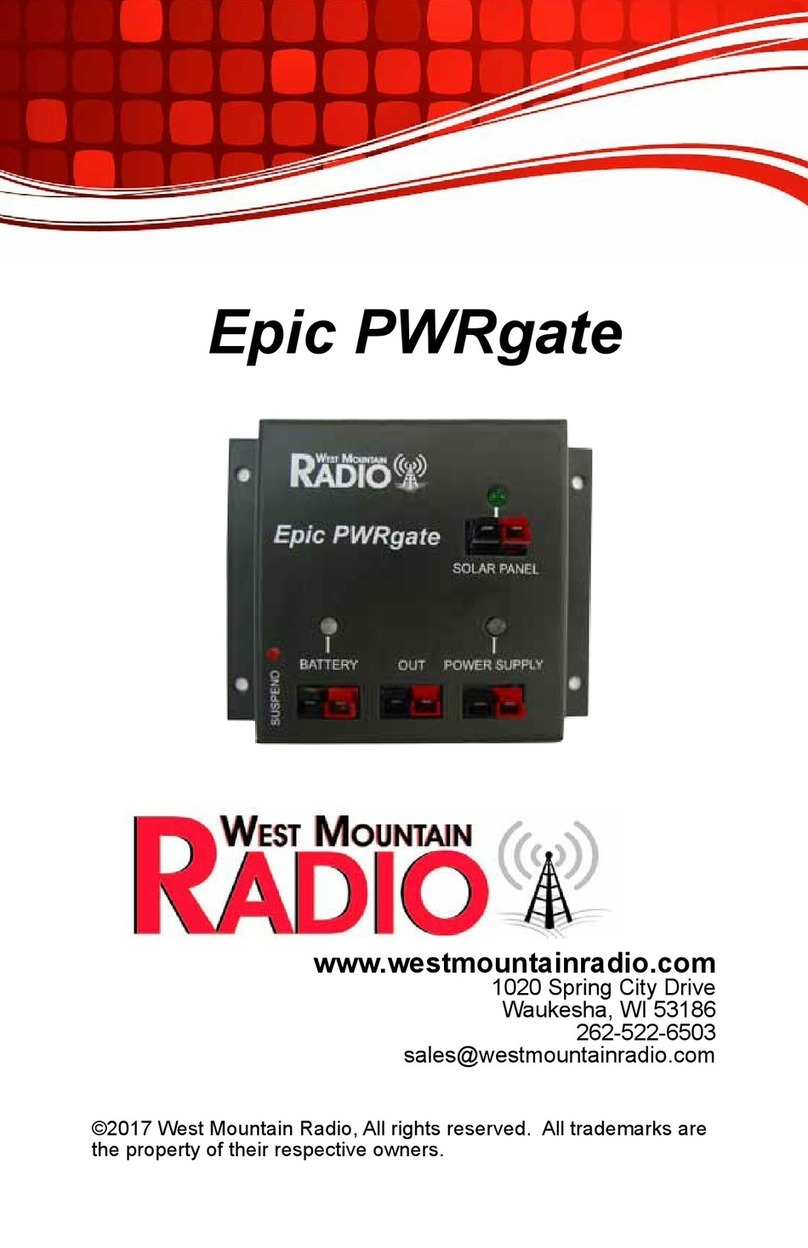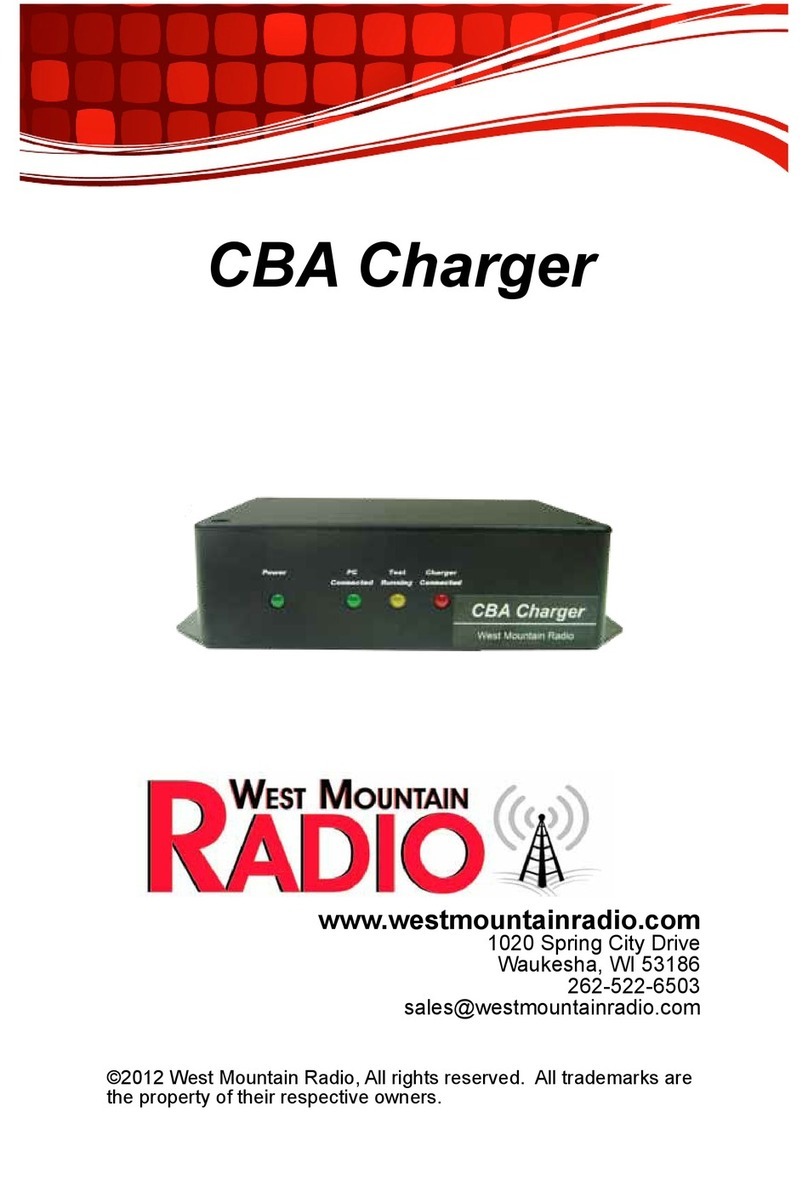West Mountain Radio Battery Box User manual

www.westmountainradio.com
1020 Spring City Drive
Waukesha, WI 53186
262-522-6503
©2012 West Mountain Radio, All rights reserved. All trademarks are
the property of their respective owners.
DCtoGO Battery Box
w/ RIGrunner 4008 and
Super PWRgate PG40S

2
West Mountain Radio Operating Manual
Thank you for choosing the West Mountain Radio DCtoGO Battery Box w/
Rigrunner 4008 and Super PWRgate PG40S! You will enjoy powering your
equipment from a portable battery using Powerpole connectors.
The DCtoGO gives you convenient portable power. The case accepts
Group Size 24 batteries, providing up to 100 amp hours at 12 volts. Eight
devices may be plugged into the integrated RIGrunner 4008 power strip.
Each socket is fused for protection. Any blown fuse will be illuminated.
Correct and low voltage indicators show battery status. The battery may
be charged via the power strip.
Contents
• Battery Box with strap
• RIGrunner 4008 (mounted directly to battery box)
• Power Supply Cable (2ft. #10 wire, ring terminals to Powerpoles
• 12 pair pak of 30A Powerpole connectors and contacts
• DCtoGO Operating Manual
Safety Information
A battery stores a large quantity of energy. A short circuit will release this
energy rapidly causing the wire to melt, and perhaps, catch on fire. Also,
the battery could explode. The fuse located near the battery terminal in the
RIGrunner may help prevent these types of catastrophes.
Batteries
The use of only SAFETY batteries is recommended, such as gelled-
electrolyte and absorbed-glass mat (AGM) types. These batteries are sealed
and contain no dangerous gases. These types may be mounted in any
position, although vertical is preferred. They are also 100% maintenance
free.
Use of other types of batteries for portable use in the DCtoGO is NOT
recommended. Automobile batteries and marine batteries may only be used
if the installation is fixed; where the battery box will not be turned over and
is located outdoors or in a welll-ventilated area.
West Mountain Radio carries high-quality gelled-electrolyte and AGM
batteries. They have posts and lugs with studs to match the ring terminals
on the supply cable provided.

3
West Mountain Radio Operating Manual
DCtoGO battery box will fit Group Size 24 batteries with the following
dimensions:
Length 10 7/8 in. (276mm)
Width 6 3/4 in. (171mm)
Height 9 7/8 in. (251mm)
Connecting to the Battery
The RED wire with the larger ring terminal is connected to the battery
POSITIVE lug and securely fastened down with the nut. The BLACK wire
with the smaller ring terminal is connected to the battery NEGATIVE lug
and securely fastened down with the nut. Ensure that RED is POSITIVE
and BLACK is NEGATIVE.
Bring the wire out through the front of the battery box to the left of the
RIGrunner. Plug into the farthest left connector marked “DCIN”. Neatly
fold the excess wire into the box. Make sure the top is oriented so that the
large vent is facing the front. Snap the top into place.
West Mountain Radio carries post-to-stud lug sets. The positive lug matches
the larger size battery post and has a 3/8 inch stud. The negative lug
matches the smaller size battery post and has a 5/16 inc stud.
Using the Strap
The strap may be installed and used both to secure the battery box to the
floor and to restrain the top cover. It also provides the safety precaution in
the event the battery explodes, the plastic box with strap will likely prevent
flying debris and acid.
Note that the strap is easily installed between the RIGrunner and the battery
box.
RIGrunner 4008
There are some considerations to think about. Please read these instructions
carefully before setting up your RIGrunner.
Choosing a mounting location
Pick a location that is close, or central to, most of your radios and
accessories; especially those that draw large amounts of current. Locate
your power source as close as possible to the RIGrunner. Remember that
every wire has resistance, longer wires have more resistance. More than
a 10’ run of #10 wire is not quite adequate to supply the RIGrunner to full
output without a significant voltage drop.

4
West Mountain Radio Operating Manual
Install in a cool dry place with good ventilation. For example, do not put
it on top of your amplifier or room heater, or cover it with something. It is
recommended to not put it in the engine compartment of your car, or directly
on the floor of a car; rain from open windows or snow covered boots may
cause water damage.
Connecting your equipment
Recognizing that RIGrunner comes standard with Powerpoles, updating
your cables that supply or use 12 volts DC with Powerpoles will improve the
convenience of quick connections and use of your equipment. Remember,
Powerpoles are genderless and the same connector arrangement works for
both supply and load. Powerpoles can be used to charge or power batteries,
all using the same connectors.
Powerpoles can be installed by soldering or crimping. Be sure to make
good connections. For detailed Powerpole connector installation tips see
RIGrunner support pages at http://www.westmountainradio.com/supportrr.
IMPORTANT!! It is essential that assembly of the pairs is correct. Follow
the amateur radio standard used by the RIGrunner. DO NOT PLUG IN
without verifying that
RED + PLUS and BLACK – MINUS is correct.
The far left connector is labeled DCIN with a 40 amp fuse, and is normally
used to connect to the power supply; but, any output may be used as the
input with an appropriate fuse. Plug in your equipment starting with the
highest power connections to the left and the lower power drain units to the
right, notice the supplied fuse ratings next to the connector chosen. Typically
12 volt input amplifiers and 100 watt RF output transceivers should be first,
VHF radios next and smaller accessories last.
Multiple amplifiers and/or transceivers may be connected to the RIGrunner.
There is a 40 amp maximum that would be exceeded if trying to transmit
all connected units at once. Most radios and amplifiers draw less than 3
amps in receive, but require many more amps in transmit. Therefore, the
limiting factor is total current draw while transmitting. To determine how
many radios may be used to transmit at one time, consult the radio manual
for power consumption specifications. In the event that the total current
goes over the 40 amp maximum, a fuse will blow or make an undersized
power supply unhappy. The RIGrunner and any equipment plugged into the
RIGrunner should go unharmed.

5
West Mountain Radio Operating Manual
Using the proper fuses
The RIGrunner comes supplied with a range of fuses installed. This assortment
should be suitable for most stations, but can be changed easily. Every RIGrunner
output is safe up to 40 amps, but the total allowable is also 40 amps.
A fuse MUST be in each position in use. ANY ATTEMPT TO BYPASS
OR SHORT ACROSS THE FUSES IS DANGEROUS AND VOIDS THE
RIGRUNNER WARRANTY. Since the maximum available automotive fuse
is 40 amps, the RIGrunner will be protected as long as any value ATC/ATO
fuse is installed. Choose the correct fuse for your equipment. Standard ATC/
ATO automotive blade fuses are used. These fuses are available in 10 values
ranging from 1 amp to 40 amps.
The DC input should have a fuse that is appropriate for the power supply rating.
If using a smaller power supply, consider using a lower value fuse than the 40
amp value supplied. Ideally all of the outlets should have a fuse that is the next
higher value above the maximum current draw of the unit on that fuse. If using a
power cord with a fuse, match that value or go one or two values higher. Sizing
each fuse for each unit is desirable, but not absolutely necessary. Having a
higher value than the minimum will offer less protection for that unit, too low a
value and the fuse will blow out prematurely.
Note that each fuse position has a LED blown fuse indicator that will conveniently
light up if an output fuse is blown. There must be power to the RIGrunner and
a load on the circuit that has the blown fuse for the blown fuse LED to light.
The voltage comparator and audible alert
A feature of the RIGrunner 4012 and 4008 is the precision expanded scale
voltage comparator display with audible alert. (The 4005 and 4004U models
do not have this feature.) A basic explanation of 12 volt systems will aid in
understanding this feature. Equipment commonly referred to as 12 volt is actually
a nominal 13.8 volts. For example, a lead acid battery is a nominal 12.6 volts
when charged and not under load, and approximately 14.0 volts under charge.
A quality 12 volt power supply will have its regulated output set to 13.8 volts.
Most radios are specified to require 13.8 volts +/- 15%. 12 volt automobile or
aircraft alternators have voltage regulation set between 13.5 and 14.3 volts.
Table of contents
Other West Mountain Radio Batteries Charger manuals



















